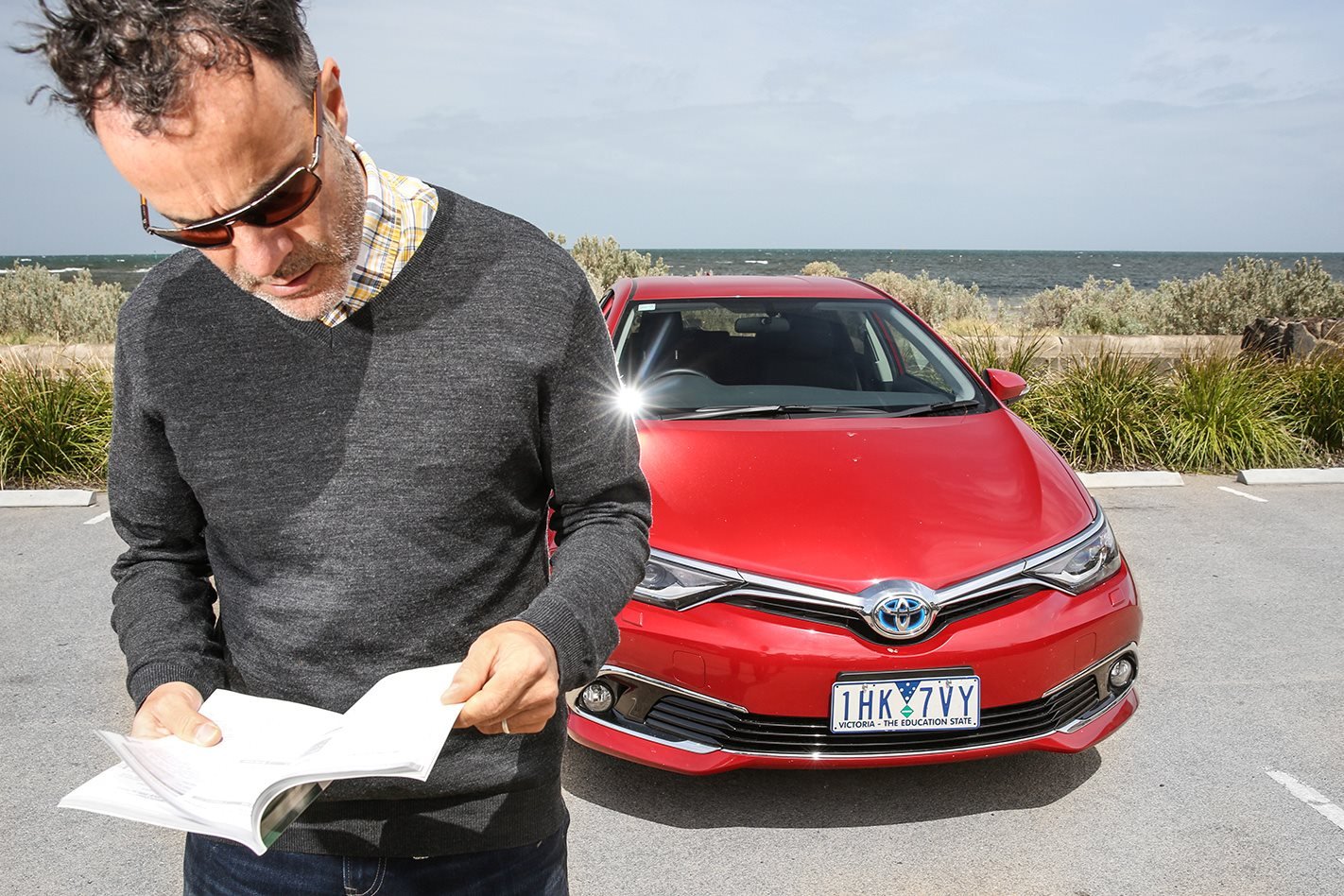
Australia’s biggest selling brand’s future is literally riding on TNGA (Toyota New Global Architecture).
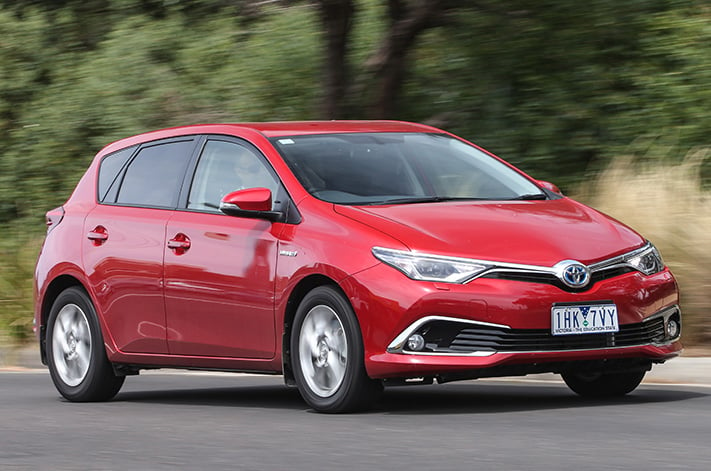
So why is one of 2012’s biggest debutantes, a homely Corolla finished in fetching Wildfire Red, draped across these pages instead? Basically, we have to wait for our brand-new Prius i-Tech to arrive from Japan. So for the next two months, Toyota has kindly offered us the recently released (in Australia) Hybrid.
Somewhat ironically (considering how utterly unchanged it is visually from your garden-variety Toyota Corolla on the outside) the petrol-electric version stumps up something new (for the series) underneath, in the form of a double-wishbone rear suspension layout, turfing out the conventionally powered version’s torsion-beam arrangement. Just like the European-market Auris.
Weighing 55kg more than an equivalently equipped Corolla SX Hatch, the Hybrid employs a variation of the previous Prius’s ‘Synergy Drive’ system, featuring a high-compression 73kW/142Nm 1.8-litre four-cylinder petrol engine and a 650V 60kW electric motor, for a combined total of 100kW. The nickel-metal hydride battery pack resides beneath the back seat and allows for less than 2km of pure electric driving range (at a maximum of 40km/h), so it’s best to focus on the reduced fuel consumption this Hybrid offers compared to a regular Corolla.
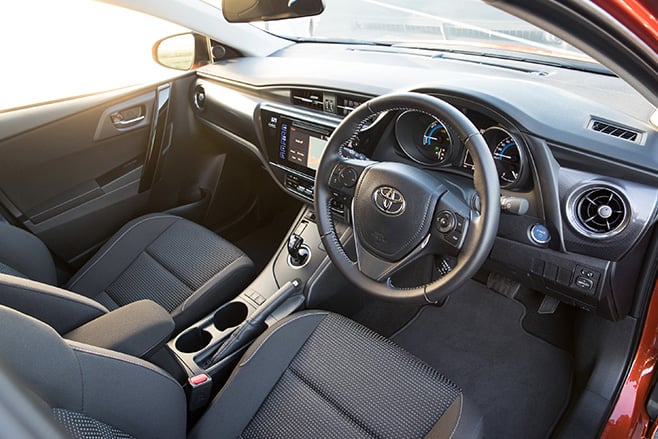
Officially it’s 4.1L/100km (two litres less than its petrol equivalent), but we managed a still-credible 5.5L/100km, and that included heavy city traffic as well as some freeway/highway driving with the car packed to the rafters with holiday gear, 190kg of humans, and one 26kg Labrador.
Larger (and electronically controlled) four-wheel disc brakes are also fitted, so the $27,530 RRP seems pretty reasonable, particularly as the Hybrid also includes satellite-navigation, a rear camera, 4.2-inch central touchscreen, auto-levelling bi-LED headlights, dual-zone climate, keyless entry and start, and 16-inch alloys shod with 205/55R16 Michelin Energy tyres.
Metallic paint adds $450, while for MY17, buyers can opt for the newly announced Autonomous Emergency Braking, as part of a $750 Safety Pack that also brings blind-spot monitoring and auto high-beam headlights.
Four weeks in, the Hybrid’s packaging has surprised by offering decent levels of space up front and sufficient room out back as long as rear occupants aren’t too tall, being perched up so high above the aforementioned battery pack.
Speaking of which, the seamless ease in which the series-parallel hybrid system switches between modes is impressive, as well as the general smoothness of the whole powertrain. The Hybrid’s steering is eager (if a tad artificial), and acceleration is satisfyingly brisk, especially in Power mode.
On the flipside, gripes include grabby brakes (is this a trait in all hybrids?), short-travel and disappointingly unsettled suspension, and the monotonous drone from the CVT under heavy acceleration.
Yet, as My First Hybrid (if the Yaris-based Prius C is too small), this Corolla succeeds in being interesting enough to be a welcome fill-in. With diesels fast falling out of favour, maybe one day every version of Australia’s best-selling passenger car will have some sort of petrol/electric propulsion.
Another reason why Corolla Hybrid is one of 2016’s most important arrivals.
Update #1
By Byron Mathioudakis
HAVE you heard the one about the hybrid that was fun to drive?
Aside from the now sadly discontinued Honda CR-Z, the words ‘fun’ and ‘hybrid’ are about as synonymous with each other as ‘Adele’ and ‘reggae’.
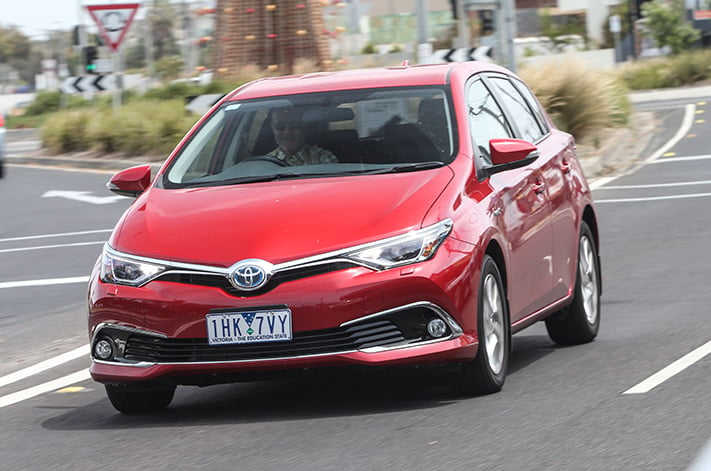
But, with a combination of newly adopted double-wishbone independent rear suspension and an electric motor set-up forcing an additional layer of instantaneous torque as required, the Toyota Corolla Hybrid shows promise … and one that it could keep.
In just over eight weeks of hot summertime inner city and urban commuting, we’re already chuffed with our circa-6.0L/100km parsimony, and with absolutely no effort to be economical at all.
Show the Hybrid a winding, tightly twisting ribbon of ragged road, however, and another side to this car appears, its mood switching from green to red to match the scarlet Wildfire paint.
Far from shirking away from the task, this Corolla’s chassis is right up for it, hunkering down as speeds increase with a neutral, flat attitude over jagged edges that sets the rear axle skipping in lesser versions.
Likewise, around town, with four bods on board, that double wishbone posterior shows its mettle by providing ample cushioning from bumps and humps – and, again, that’s something that the torsion-beam back end in regular Corollas has failed to accomplish in previous tests.
Additionally, our Hybrid is deceptively speedy. With a few thousand clicks under its green belt, 1HK-7VY tears along at a cracking pace once on the move, riding on a wad of torque that just isn’t there in the conventionally powered model. And that’s before pushing the ‘Sport’ button that hurries up that surprisingly alert ‘E-CVT’ continuously variable transmission. We predict some drivers might find themselves with some unexpected fines in the mail before too long.
On the flipside, the steering remains an almost completely feedback-free zone, responding well enough to inputs, but never at all feeling natural or connected.
A propensity to very suddenly weight up mid-turn reveals a tuning inconsistency here, though it never becomes too heavy or unwieldy.
There’s also too much noise from the road, suspension and tyres coming through to the cabin. And the eager, grabby brakes are never quite as smooth as we’d like them to be. So while this isn’t quite a Golf GTI alternative just yet, there is still plenty for drivers to enjoy.
Fun to drive and cheap to run. Another reason why the Hybrid has already shaped up as the best Corolla sold in Australia in decades. And that’s no joke.
Update #2
By Byron Mathioudakis
IN JUNE 1967, Toyota launched the Corolla in Australia. Three months later I was born. And almost to the day 30 years after that, the first production series-parallel hybrid system debuted internationally wearing a Prius badge.
Now all three of us coalesce to this – my final report on a model that was quietly released in mid 2016 as Japan’s first petrol-electric alternative to the increasingly on-the-nose Euro turbo-diesels.
Honestly, however, I wasn’t sure I’d enjoy three months of Corolla Hybrid stewardship.
Previous experiences with the regular 11th-gen hatch out since 2012 left me thinking that Toyota dialled it in.
Distinctive design and total reliability are both fine and good, but sub-par refinement, comfort and driver appeal against over-achievers like the Volkswagen Golf and (latest) Subaru Impreza reeks of complacency.
In our recent base petrol auto small-car megatest (January 2017), Australia’s number one selling passenger car could only manage a measly tenth.
What happened to the successors of that original Corolla KE10 1100 that, in its first comparo (Wheels, October 1967), was declared “the nicest overall to use”? Well, nearly 3800km later, the Hybrid isn’t your garden variety Corolla.
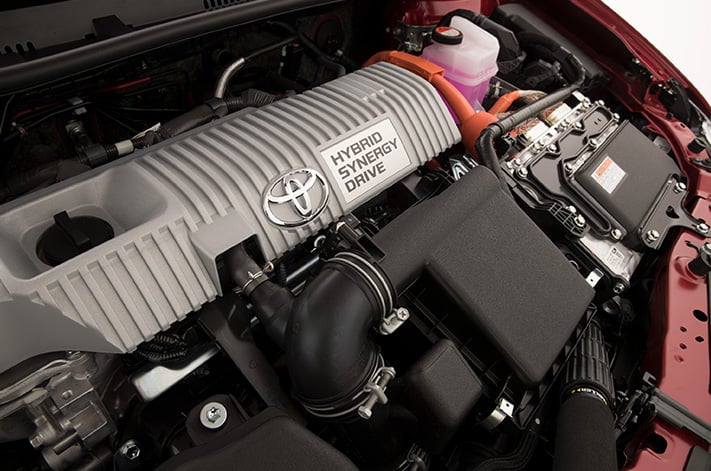
To recap, it ditches the ageing 103kW/173Nm 1.8-litre four-pot petrol lump for a 73kW/142Nm 1.8-litre Atkinson Cycle unit married to a 650V 60kW electric motor and nickel-metal hydride battery pack (for 100kW combined and just under 2km of pure electric range at up to 40km/h.) It also bins the torsion beam rear for a pair of double wishbones.
What I discovered was that while the regular Corolla’s tyre noise intrusion largely remained, the suspension was less busy and bouncy, particularly with four people on board.
Secondly, despite numb steering, the Hybrid handles with more composure and control, especially at speed and/or over bumpier roads.
Thirdly, this thing really hustles.
And, lastly, it averaged just 5.4L/100km. Yes, that’s wide of the 4.1L/100km claim, but not bad for real world devil-may-care driving.
Here, then, is the first Corolla in generations that is genuinely innovative, without compromising half a century of functionality and reliability.
For the money the Hybrid represents outstanding value against far more expensive Euro diesels while delivering palpably better economy, handling and ride qualities than its normal petrol siblings. The Hybrid is the pick.
Respect, then, to that other 50-year-old. I hope I’m as fit and efficient come this October. Meanwhile, next month, it’s the all-new Prius i-Tech’s turn. At just 20, will it also win us over?



